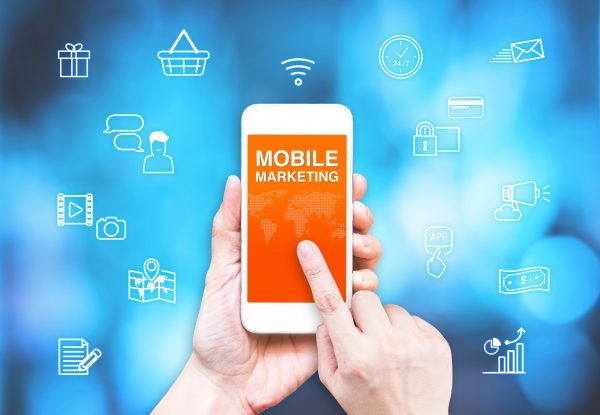
by Francois Muscat | Jul 7, 2020 | Mobile Marketing
It doesn’t matter if you’re a kid or an adult; no one is really immune to trends and fads, especially mobile trends! Marketers, especially digital marketers, need to understand the difference between mobile trends that will be impactful to their operations and those pesky fleeting fads.
Fads and trends: From old-school to modern mobile trends
Many moons ago, the schoolyards were filled with marbles; then it was pogs, followed quickly by Pokémon cards and, of course, devil sticks. I remember having these things separately but also all at once, though the reality is each one likely had a really entertaining month or two and then ended up in a forgotten drawer next to the rest of the fads.
Like a schoolyard at recess, the digital world is filled with trends, fads and every kind of shiny, fool’s-gold type object you can imagine.
This is a problem for both marketers and consumers. Whether it’s an ad campaign or landing page that convinces you to buy a product you don’t want or need or a marketing technique that fails to deliver on its too-good-to-be-true promise, it’s often difficult to avoid the pitfalls of the Internet.
There are, however, new technologies and trends that can have a significant effect on both consumers and marketers, which means telling the difference between impactful mobile trends and fleeting fads is an important skill.
Measuring trends and fads with the Pokémon GO Barometer
Pokémon GO is the perfect example of how to tell the difference between impactful mobile trends and fleeting fads because it transcends whether or not you have an actual experience with it.
Pokémon GO is changing the future of local marketing. It is impacting how consumers are shopping, which in turn affects how local brands are marketing to consumers (a group you are part of, even if you’re not playing Pokémon GO).
Additionally, the technology behind Pokémon GO – augmented reality – has captured the minds of brands and marketers and opened up a whole new line of connection with consumers. Within the augmented reality world, consumers play a game; in the real world, those consumers enter brick-and-mortar stores to achieve certain goals in their game. It’s genius.
What’s the difference between impactful trends and fads?
The big question remains: how do you tell the difference between an impactful mobile trend and a fad? Truthfully, there are no hard and fast rules.
The best way to think about impactful trends and fads is to ask yourself whether the game, tactic or strategy in question has crossed over into areas of your life where it may not belong. For example, the Pokémon GO conversation makes sense in schoolyards, but it’s everywhere else, too: in bars, on the news, in offices and at dinner tables around the world.
Chances are you will fall victim to a fad, and that’s okay. We’re all trying to make a difference for our brand or company and, at the end of the day, doing something – anything – to try to move the needle forward is better than sitting on your hands. Many fads are effective for short periods of time, they just don’t work as long-term staples.
For example, infographics have been called a fad before (albeit a multiple-year fad). While infographics may very well be in the autumn of their lifespan, many brands and companies have achieved great success with infographic marketing (us included!).
A big part of fading fads is an intuition about how a certain thing will affect people and society, but another component of it is simply ignoring the label. If something is working for you and your brand, who cares what other people call it?
Impactful trends like Pokémon GO are definitely fun, but there is a more profound impact than the novelty value alone. It has changed the way we do digital and mobile marketing. If you can add some fun to your campaigns while buying in on impactful trends, you might improve the efficacy of your campaigns. For more information on mobile trends and help with your digital marketing strategy, contact WSI today.

by Marianna Muscat | May 6, 2020 | Mobile Marketing
If your mobile marketing campaigns are not yielding measurable results that help your profitability and business growth, you’re wasting time and money. The aim of mobile marketing should not just be to create beautiful visuals and marketing materials, it should be to find new customers, retain current ones and increase your business’ revenue
Perhaps the above is stating the obvious, but how do we actually measure these variables? Well, in order to do so, you need to focus on a set of central key performance indicators (KPIs). Here are the four main KPIs your mobile analytics should be tracking daily so as to ensure you aren’t just ‘winging it’ with your marketing efforts:
4 Main KPIs to track in your mobile marketing
1. (Cpi/Cpa) Cost per Install and Cost per Acquisition
This is a question of the feasibility and profitability of your business, as well as the cost-effectiveness of your mobile marketing. Whatever analytics system you are using, make sure it can tell you exactly how much it costs you to acquire one new user/customer. You can then adjust your marketing budget accordingly or, if all goes well, have real figures to take to your finance department when they question your ad spend.
2. (CLTV) Customer Lifetime Value
This crucial metric tells you how much gross profit is generated by a single customer over the entire time you are doing business with them. It’s calculated by multiplying the average period payment (say your monthly or annual subscription fee) by your average gross margin and the number of periods the customer is expected to be with you. Together with your CPI/CPA measurements, this metric enables you to work out and project the profitability of individual users and groups of users. This helps you know where to focus your marketing and customer retention efforts.
3. (DAU) Daily Active Users
Acquisitions are fine. But, they mean little to your business in the long run if they don’t translate to consistent, regular customers. This KPI enables you to see how many active customers you have and to set goals for their retention, as well as for the addition of new active customers and the targeted acquisition of more.
4. Impact on Revenue
What is the net impact of your mobile marketing on overall revenue for the business? This is something you can and should measure. It is perhaps the simplest KPI to measure. The figures acquired from this, together with your user data, will often enable you – or your analytics software – to calculate the three KPIs above, as well as a range of others.
If you want to improve your mobile marketing efforts, you need to start using analytics and tools to ensure that your efforts are targeted and scientific and that you have statistics to help you make sound decisions. Using analytics can help you to see which of your efforts are working and which are not, giving you the information you need to redirect your strategies. Contact WSI OMS, mobile marketing experts, to help you to adapt and refine your campaign.

by Marianna Muscat | Apr 29, 2020 | Mobile Marketing, Social Media Marketing, Social Networking
South African’s, whether urban or rural, are all using mobile phones to access information on the latest news or search for products and services. Marketing strategies must now adapt to include mobile marketing. Every business should have a mobile-responsive website designed to respond to the screen size of the device used by its customer. This kind of positive user experience will make customers stay on your site longer, instead of moving on quickly.
Snapchat, a mobile messaging application (“app”) used to share photos, videos, text and drawings, are very popular with Millennials and Generation X, probably because the downloading of the app and sending of messages are free. Snapchat is not known to be marketing-friendly, but with the introduction of Snapchat Discover, this has changed slightly. Snapchat Discover is still not user-friendly for small businesses, but it is a good platform to get inspiration for the Facebook or Instagram story content of your business.
What Is Snapchat Discover?
Snapchat Discover is a page on the Snapchat app that shows story-styled content from brands, major influencers and brands that partner with Snapchat.
How Do Big Brands Use Snapchat Discover?
Let’s look at how National Geographic and Harvard Business Review use Snapchat Discover for visual storytelling.
National Geographic
National Geographic posts content to Snapchat Discover similar to what you might see on its television channel or magazines. However, because platforms such as Snapchat are so fast-paced, National Geographic often adds interactivity to their Stories. Their Stories also read more like fun-facts or news bytes, to keep users engaged. Exposed to the National Geographic brand on Snapchat, users might even start following them on other channels.
Harvard Business Review (HBR)
Harvard Business Review uses Snapchat Discover to tell easy to understand Stories about complex topics that include technology, finances, global warming, academics and job seeking. A mix of harder content and advise-orientated content, Harvard Business Review uses a mix of snap-based Stories, swipe-up Stories, video, animation and even interactive elements such as polls or quizzes.
Connect with WSI OMS if you want to start communicating with your target audience on their preferred platform and use mobile marketing to promote your business.

by Francois Muscat | Oct 28, 2019 | Mobile Marketing
Text message marketing is a great way to gain visibility in front of your loyal followers and customers, but how do you do it? What’s the best way to take advantage of text message marketing to grow your business? And, furthermore, why text message marketing over email?
We get that question all the time! And the reason is that text message marketing gets in front of people instantly, and basically, everybody sees it. With email, there’s a little bit more of a delay because people don’t check their email in real-time. In this blog, we’re going to give you examples of how you can use mobile marketing to make your brand stand out.
1. Include Calls to Action on Your Website
For an e-commerce store, a good text message marketing campaign might be something like an instant coupon. Maybe somebody is on your e-commerce store, they’re on the check-out page and you have a lot of abandoned carts and you want to try to reduce that. Put a call to action on the page: “Hey, opt in to our text message campaign right now and get an instant coupon for 20% off.” This helps customers move forward through the buying process.
2. Give People the Information They Want
A dance studio has classes and scheduling. Maybe classes need to move out due to bad weather. This would be information that would be super important to get in front of people in real-time. Email wouldn’t be as effective here, right? Text is much more effective if the class was cancelled because of a heatwave or a big traffic pile up, for example. In this case, people will be grateful to get a text message because it gives them important information they need to plan their day.
3. Offer Worthwhile Specials and Deals
A restaurant is another great example. It’s a slow day on Tuesday at lunch, right? Instead of just sitting there with a slow day, you can send a text message out to the loyal followers of your restaurant and tell them there’s a buy-one-get-one-free burger deal or 30% off lunch menu items, for example.
4. Make Sure You Have Permission to Text
With text message marketing, you can’t just put somebody’s phone number into a text message marketing software programme to text them. That’s against the rules. They need to actually opt-in to receive the information that you want to provide. So, what you need to do is think about where are you going to get this call to action out in front of people. If you own a restaurant, this should be in-store, on the table or on the menu. If you have an email subscriber list, consider including the option to opt-in in a newsletter.
Need help with your mobile marketing, content marketing or SEO? Then contact WSI OMS today.

by Marianna Muscat | Jun 10, 2019 | Mobile Marketing
Four years ago, Amazon started to wonder what would a grocery store look like if people could walk in, grab what they wanted and just go? What would happen if they could weave the most advanced machine learning, artificial intelligence and computer vision into the fabric of a store so that shoppers never had to wait in line?
This is exactly what Amazon achieved with their first Amazon Go store, which was launched in Seattle in 2019. There are no lines and no cashiers.
How Does it Work?
Shoppers need to download the Amazon Go app and scan their phones on the way into the store. Then they can put away their phones and start shopping. Anything that is picked up is automatically added to the virtual shopping cart on the Amazon Go app. If you change your mind, all you have to do is put it back and the technology will update the virtual cart automatically. Once you have everything you want or need, you can just walk out. Everything will be added up and charged to your Amazon account.
Amazon used sensor fusion, deep learning algorithms and computer vision that is similar to that found in self-driving cars for their first Amazon Go store. They call it ‘just walk out technology’. If brick and mortar shopping is getting this easy and seamless, consider what the future will hold for people looking to use mobile marketing to target shoppers in specific locations.
Need help with your digital marketing, social media marketing or SEO? Then contact WSI OMS today.

by Francois Muscat | Mar 13, 2019 | Mobile Marketing
If you are a small to medium-sized business just starting out with mobile marketing, you will probably find the sheer volume of information available online mind-boggling. To streamline your approach, our digital marketing company has created four clear best practices for your business:
Making customers feel secure about your communications is an essential starting point. The vast majority of people are annoyed to receive messages from senders they have not approved (just think about how ticked off you get when you receive unsolicited spam from companies). The best engagement will come from simply asking your customers for their consent.
Mobile marketing evokes negative sentiment. For starters, you need to understand the reasoning behind this. According to statistics from digital security company Gemalto, annual survey respondents had the following to say:
- 77% said they received an offer that was not in line with their interests,
- 75% said it was difficult to opt out of the communication, and
- 80% felt that the benefit they received was not attractive.
Customers can be divided into four categories:
Marketing Immune
27% belong to the category marketing immune with no interest in the benefits offered by mobile messages,
Easy Going
27% belong to the category easy going with no need to be in control but with limited impact on purchases,
Control Freaks
29% belong to the category control freaks who need to be in control of incoming messages and remain interested in mobile marketing, and
Connected Marketing Lovers
18% belong to the category connected marketing lovers who are interested in promotions or other benefits and do not need to be in control.
It should, therefore, be clear that the segmentation of customers will ensure a more effective approach.
Send the right message to the right person at the right moment. Over half of the people surveyed were happy to receive certain types of messages when relevant, and 52% said they would take advantage of an immediate discount.
Need help with your mobile marketing or digital marketing campaign? Then contact WSI OMS today.






